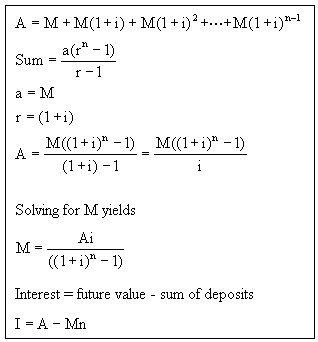

The future value of a savings plan (implemented as an ordinary annuity) is the sum of the future values of all of the deposits. Each of these future values is calculated using the regular compound interest formula.
![]()
In the context of a savings plan, M is the present value of each investment. Remember that the deposits are made at the end of the period. Consequently, the first deposit will earn interest for only n-1 periods, the second deposit will earn interest for n-2 periods and so on. The next to the last payment will earn only one period's interest. The final deposit, made at the very end of the term will earn no interest at all. The future values of all of the deposits are listed in the table below.

The values in the second column can be listed from last to first as shown here.
![]()
Notice that each term after the first is (1+i) times the preceding term. A series of numbers having this property is called a geometric series. You may have encountered geometric series before in an algebra course. Conveniently, there is a formula for finding the sum of a geometric series. In this formula (in the second line below) the variable "a" represents the first term in the series (M) and the variable "r" represents the multiplier (1+ i).
